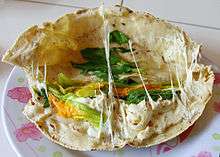Calabaza

Calabaza, or West Indian pumpkin, is a winter squash typically grown in the West Indies and tropical America.[1]
The word calabasa is derived from the Persian term for melon (kharbuz). The French term calabasse, and hence the English "calabash", is based on the older Spanish.[2][3]
Calabaza is the common name for Cucurbita moschata (Duchesne) in Florida and Puerto Rico. C. moschata (Duchense) is also popular in the Dominican Republic where it is called it is called auyama, ayote in Central America, zapallo in South America, and pumpkin and/or calabash in English-speaking islands.[4]
Cultivars
In North America, the Spanish word "calabaza" may refers to any of several species of squash of the genus Cucurbita. The term is most commonly used for cultivars of the species C. moschata, which is native to the Caribbean. The skin color typica, varying from dark green to light yellow. The flesh can also vary in color, but most common is bright orange or yellow. Varieties differ somewhat in taste and texture, but are generally slightly sweet with a firm but soft texture. Cultivars of the species C. maxima may also use the term if they resemble the C. moschata cultivars, and widespread species C. foetidissima specifically identifies "calabaza" as one of its common names.[5]
Botanical description
Calabaza plants are monoecious and are pollinated by insects like honeybees and bumblebees. The plants have long internodes and have vines that are up to 15 m from the crown of the fruit to the plant. Most plants have vine-type growth; however, there are some Cucurbita moschata (Duchesne) that are recorded to have bush-type growth. They yield 2-15 fruit on average, but the bush types provide higher yields.[6] The fruit may weigh 5 to 50 pounds, and fruit shape varies from oval, spheroid, obovate, pear, oblate, to elliptic. Improved types tend to be spheroid, oblate or flat. The rind varies in color from a light to dark green when immature and a light orange to beige when mature, and can be smooth or warted. The inside flesh is green-yellow to orange in color and is about 1-3 inches thick.[7]
Uses

Calabaza is eaten many different ways, such as in stews, cakes, and candies. It can also be used in place of pumpkin varieties. The taste is smooth and somewhat sweet. Calabaza is a good source of beta-carotene, some of which can be converted into vitamin A.
Under Spanish colonial influence, squashes became established in other regions. C. maxima and C. moschata, in particular, are well known in the Philippines under the name kalabasa.[8][9]
The flower (flor de calabaza) is used as an ingredient in quesadillas, empanadas and other dishes in Mexican cuisine and New Mexican cuisine, and in pupusas in Salvadoran cuisine.
The seeds, toasted and seasoned, known as pepitas, are a common snack.
References
- ↑ "Calabasa". Merriam-Webster. Retrieved February 15, 2015.
- ↑ "Calabash". Online Etymology Dictionary. Retrieved April 27, 2011.
- ↑ "Calabash". Dictionary.com. Retrieved April 27, 2011.
- ↑ "Flowering Habit, Yield, and Fruit Shape of Calabaza Cultigens" (PDF). Florida State Horticultural Society. Retrieved November 7, 2017.
- ↑ "Taxon: Cucurbita moschata Duchesne Genus: Cucurbita". Agriculture and Agri-Food Canada. March 2, 2006. Retrieved February 15, 2015.
- ↑ Wu Tao, Zhou Jiehong, Zhang Yafeng, Cao Jiashu (2007). "Characterization and inheritance of a bush-type Tropical Pumpkin Cucurbita moschata (Duchesne)". Scientia Horticulturae. 114: 1–4. doi:10.1016/j.scienta.2007.04.014. Retrieved November 6, 2017.
- ↑ "Flowering Habit, Yield, and Fruit Shape of Calabaza Cultigens" (PDF). Florida State Horticultural Society. Retrieved November 7, 2017.
- ↑ Irma Remo Castro (2006). A guide to families of common flowering plants in the Philippines. UP Press. p. 73. ISBN 978-971-542-525-4.
- ↑ Wendy Hutton (1997). Tropical Vegetables. Tuttle Publishing. p. 27. ISBN 978-962-593-149-4.
| Wikibooks Cookbook has a recipe/module on |